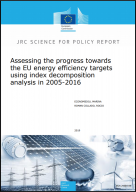Details
- Publication date
- 1 January 2017
- Author
- Joint Research Centre
Description
Energy consumption trends are driven by several factors beyond energy efficiency, including economic activity, demography, lifestyle changes and weather. These can all have a profound effect in the aggregate energy use, irrespective of the impact of energy efficiency policies and measures. As more and more countries are relying on their energy efficiency targets as a means to address unprecedented challenges resulting from increased dependence on energy imports, scarce energy resources and climate change, robust methodologies that enable monitoring and measuring progress towards these targets are increasingly important.
To identify the driving factors and their contributions behind the latest energy consumption trends in the EU, the Logarithmic-Mean Divisia Index method (LMDI) method, a widely-used IDA method, was applied to study both aggregated and sectoral energy consumption changes at EU and MS levels over the period 2005–2016 in this report.

